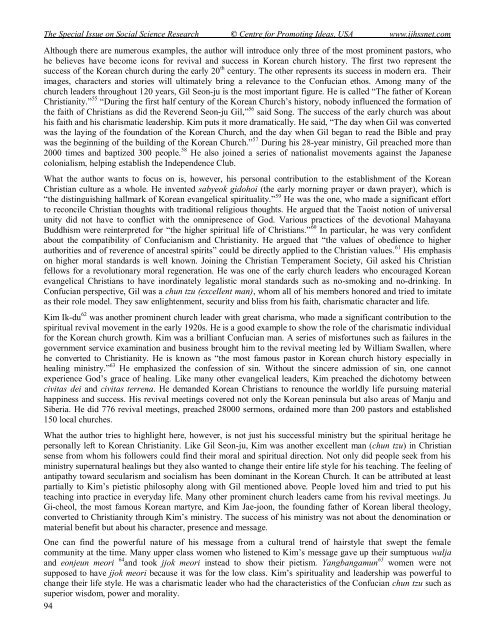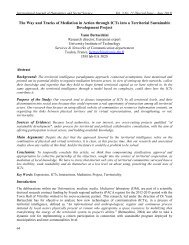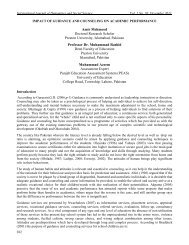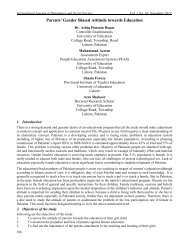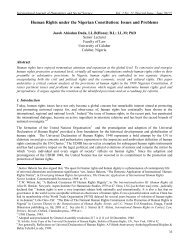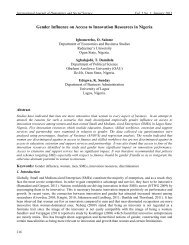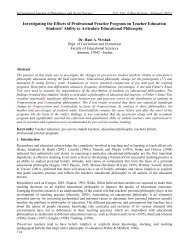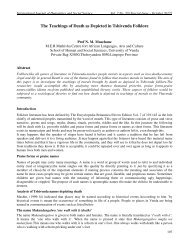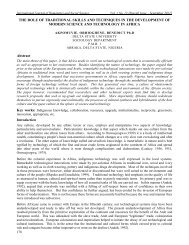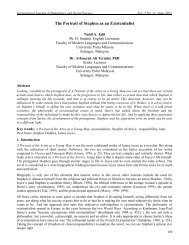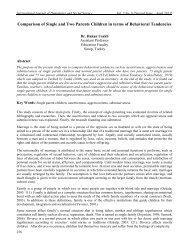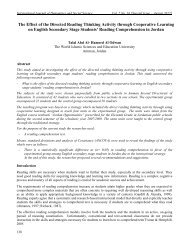Revisiting the Confucian Norms in Korean Church Growth
Revisiting the Confucian Norms in Korean Church Growth
Revisiting the Confucian Norms in Korean Church Growth
You also want an ePaper? Increase the reach of your titles
YUMPU automatically turns print PDFs into web optimized ePapers that Google loves.
The Special Issue on Social Science Research © Centre for Promot<strong>in</strong>g Ideas, USA www.ijhssnet.com<br />
Although <strong>the</strong>re are numerous examples, <strong>the</strong> author will <strong>in</strong>troduce only three of <strong>the</strong> most prom<strong>in</strong>ent pastors, who<br />
he believes have become icons for revival and success <strong>in</strong> <strong>Korean</strong> church history. The first two represent <strong>the</strong><br />
success of <strong>the</strong> <strong>Korean</strong> church dur<strong>in</strong>g <strong>the</strong> early 20 th century. The o<strong>the</strong>r represents its success <strong>in</strong> modern era. Their<br />
images, characters and stories will ultimately br<strong>in</strong>g a relevance to <strong>the</strong> <strong>Confucian</strong> ethos. Among many of <strong>the</strong><br />
church leaders throughout 120 years, Gil Seon-ju is <strong>the</strong> most important figure. He is called “The fa<strong>the</strong>r of <strong>Korean</strong><br />
Christianity.” 55 “Dur<strong>in</strong>g <strong>the</strong> first half century of <strong>the</strong> <strong>Korean</strong> <strong>Church</strong>‟s history, nobody <strong>in</strong>fluenced <strong>the</strong> formation of<br />
<strong>the</strong> faith of Christians as did <strong>the</strong> Reverend Seon-ju Gil,” 56 said Song. The success of <strong>the</strong> early church was about<br />
his faith and his charismatic leadership. Kim puts it more dramatically. He said, “The day when Gil was converted<br />
was <strong>the</strong> lay<strong>in</strong>g of <strong>the</strong> foundation of <strong>the</strong> <strong>Korean</strong> <strong>Church</strong>, and <strong>the</strong> day when Gil began to read <strong>the</strong> Bible and pray<br />
was <strong>the</strong> beg<strong>in</strong>n<strong>in</strong>g of <strong>the</strong> build<strong>in</strong>g of <strong>the</strong> <strong>Korean</strong> <strong>Church</strong>.” 57 Dur<strong>in</strong>g his 28-year m<strong>in</strong>istry, Gil preached more than<br />
2000 times and baptized 300 people. 58 He also jo<strong>in</strong>ed a series of nationalist movements aga<strong>in</strong>st <strong>the</strong> Japanese<br />
colonialism, help<strong>in</strong>g establish <strong>the</strong> Independence Club.<br />
What <strong>the</strong> author wants to focus on is, however, his personal contribution to <strong>the</strong> establishment of <strong>the</strong> <strong>Korean</strong><br />
Christian culture as a whole. He <strong>in</strong>vented sabyeok gidohoi (<strong>the</strong> early morn<strong>in</strong>g prayer or dawn prayer), which is<br />
“<strong>the</strong> dist<strong>in</strong>guish<strong>in</strong>g hallmark of <strong>Korean</strong> evangelical spirituality.” 59 He was <strong>the</strong> one, who made a significant effort<br />
to reconcile Christian thoughts with traditional religious thoughts. He argued that <strong>the</strong> Taoist notion of universal<br />
unity did not have to conflict with <strong>the</strong> omnipresence of God. Various practices of <strong>the</strong> devotional Mahayana<br />
Buddhism were re<strong>in</strong>terpreted for “<strong>the</strong> higher spiritual life of Christians.” 60 In particular, he was very confident<br />
about <strong>the</strong> compatibility of <strong>Confucian</strong>ism and Christianity. He argued that “<strong>the</strong> values of obedience to higher<br />
authorities and of reverence of ancestral spirits” could be directly applied to <strong>the</strong> Christian values. 61 His emphasis<br />
on higher moral standards is well known. Jo<strong>in</strong><strong>in</strong>g <strong>the</strong> Christian Temperament Society, Gil asked his Christian<br />
fellows for a revolutionary moral regeneration. He was one of <strong>the</strong> early church leaders who encouraged <strong>Korean</strong><br />
evangelical Christians to have <strong>in</strong>ord<strong>in</strong>ately legalistic moral standards such as no-smok<strong>in</strong>g and no-dr<strong>in</strong>k<strong>in</strong>g. In<br />
<strong>Confucian</strong> perspective, Gil was a chun tzu (excellent man), whom all of his members honored and tried to imitate<br />
as <strong>the</strong>ir role model. They saw enlightenment, security and bliss from his faith, charismatic character and life.<br />
Kim Ik-du 62 was ano<strong>the</strong>r prom<strong>in</strong>ent church leader with great charisma, who made a significant contribution to <strong>the</strong><br />
spiritual revival movement <strong>in</strong> <strong>the</strong> early 1920s. He is a good example to show <strong>the</strong> role of <strong>the</strong> charismatic <strong>in</strong>dividual<br />
for <strong>the</strong> <strong>Korean</strong> church growth. Kim was a brilliant <strong>Confucian</strong> man. A series of misfortunes such as failures <strong>in</strong> <strong>the</strong><br />
government service exam<strong>in</strong>ation and bus<strong>in</strong>ess brought him to <strong>the</strong> revival meet<strong>in</strong>g led by William Swallen, where<br />
he converted to Christianity. He is known as “<strong>the</strong> most famous pastor <strong>in</strong> <strong>Korean</strong> church history especially <strong>in</strong><br />
heal<strong>in</strong>g m<strong>in</strong>istry.” 63 He emphasized <strong>the</strong> confession of s<strong>in</strong>. Without <strong>the</strong> s<strong>in</strong>cere admission of s<strong>in</strong>, one cannot<br />
experience God‟s grace of heal<strong>in</strong>g. Like many o<strong>the</strong>r evangelical leaders, Kim preached <strong>the</strong> dichotomy between<br />
civitas dei and civitas terrena. He demanded <strong>Korean</strong> Christians to renounce <strong>the</strong> worldly life pursu<strong>in</strong>g material<br />
happ<strong>in</strong>ess and success. His revival meet<strong>in</strong>gs covered not only <strong>the</strong> <strong>Korean</strong> pen<strong>in</strong>sula but also areas of Manju and<br />
Siberia. He did 776 revival meet<strong>in</strong>gs, preached 28000 sermons, orda<strong>in</strong>ed more than 200 pastors and established<br />
150 local churches.<br />
What <strong>the</strong> author tries to highlight here, however, is not just his successful m<strong>in</strong>istry but <strong>the</strong> spiritual heritage he<br />
personally left to <strong>Korean</strong> Christianity. Like Gil Seon-ju, Kim was ano<strong>the</strong>r excellent man (chun tzu) <strong>in</strong> Christian<br />
sense from whom his followers could f<strong>in</strong>d <strong>the</strong>ir moral and spiritual direction. Not only did people seek from his<br />
m<strong>in</strong>istry supernatural heal<strong>in</strong>gs but <strong>the</strong>y also wanted to change <strong>the</strong>ir entire life style for his teach<strong>in</strong>g. The feel<strong>in</strong>g of<br />
antipathy toward secularism and socialism has been dom<strong>in</strong>ant <strong>in</strong> <strong>the</strong> <strong>Korean</strong> <strong>Church</strong>. It can be attributed at least<br />
partially to Kim‟s pietistic philosophy along with Gil mentioned above. People loved him and tried to put his<br />
teach<strong>in</strong>g <strong>in</strong>to practice <strong>in</strong> everyday life. Many o<strong>the</strong>r prom<strong>in</strong>ent church leaders came from his revival meet<strong>in</strong>gs. Ju<br />
Gi-cheol, <strong>the</strong> most famous <strong>Korean</strong> martyre, and Kim Jae-joon, <strong>the</strong> found<strong>in</strong>g fa<strong>the</strong>r of <strong>Korean</strong> liberal <strong>the</strong>ology,<br />
converted to Christianity through Kim‟s m<strong>in</strong>istry. The success of his m<strong>in</strong>istry was not about <strong>the</strong> denom<strong>in</strong>ation or<br />
material benefit but about his character, presence and message.<br />
One can f<strong>in</strong>d <strong>the</strong> powerful nature of his message from a cultural trend of hairstyle that swept <strong>the</strong> female<br />
community at <strong>the</strong> time. Many upper class women who listened to Kim‟s message gave up <strong>the</strong>ir sumptuous walja<br />
and eonjeun meori 64 and took jjok meori <strong>in</strong>stead to show <strong>the</strong>ir pietism. Yangbangamun 65 women were not<br />
supposed to have jjok meori because it was for <strong>the</strong> low class. Kim‟s spirituality and leadership was powerful to<br />
change <strong>the</strong>ir life style. He was a charismatic leader who had <strong>the</strong> characteristics of <strong>the</strong> <strong>Confucian</strong> chun tzu such as<br />
superior wisdom, power and morality.<br />
94


